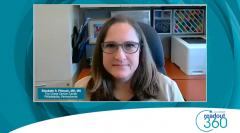
Advanced Clear Cell RCC: Impact of the CLEAR Trial on Real-World Practice
Expert panelists consider how updated data from the CLEAR trial of lenvatinib + pembrolizumab in advanced clear cell RCC have impacted their real-world clinical practice.
Episodes in this series

Transcript:
Brian I. Rini, MD, FASCO: So, let me pause there and let me…ask [this to] my faculty. And Bob, I’ll start with you, since you’re on my screen…. You presented the CLEAR [NCT02811861] updates both at ASCO [American Society of Clinical Oncology] and at KCRS [Kidney Cancer Research Summit]. So, what do you think of these long-term data? Did they change your way of thinking about approaching patients? What was the value in your practice?
Robert J. Motzer, MD: So the long term follow-up of a CLEAR trial that we reported at KCRS was really…dovetailed out of the more definitive analysis, the final prespecified overall survival analysis that was presented by Tom Hudson[, MD], at the June ASCO [meeting]. And...it was really confirmatory and reassuring of really the extraordinary efficacy that we see with this program. The response rate of over 70% is the highest response rate we’ve ever seen with any program in RCC [renal cell carcinoma] and the median duration of progression free survival of almost 24 months, again, is the longest that we’ve seen. The survival benefit...was reassuring. People have focused on...the changing HR. But...that really…reflects subsequent therapy and availability to IO [immuno-oncology] therapy, second or third line, as well as…smaller numbers of patients. And the fact that it’s not a...primary analysis of overall survival. The response rate...is really pretty amazing with CR [complete response] rates of almost 20%, many of which are durable. And so...it really…speaks to the high level of efficacy for this particular program and for the particular approach overall of TKI [tyrosine kinase inhibitor] IO therapy and first-line therapy for RCC.
Brian I. Rini, MD, FASCO: Yeah, I agree. Betsy…I showed some of the response duration numbers...and the CR was about 44 and then…decreases as you have less shrinkage. What do you think of the numbers? Is that something you’d talk to patients about? How are you going to use that?
Elizabeth R. Plimack, MD, MS: I think that’s still the most compelling number of the CLEAR trial, the very low rate of patients who progressed right through it. And so, achieving that level of control, stable disease included, is really important. And...one of the most compelling hallmarks of this particular regimen, the approach overall…in terms of durability…there’s achieving a response, there’s holding on to the response, there’s losing the response, but staying on therapy and meeting overall control, and then there’s…the best-case scenario where you can stop the drugs and continue disease control off therapy. And those are all…different versions of duration of response and all…are really good places to be…for patients. It is hard to speak for the patient in front of you in terms of their chances of reaching one of those and which one. And it’s balanced with the toxicity they may experience over time. But in general...I give the strongest regimen, the best chance of response…treat for efficacy, manage toxicity, and give patients the hope that there is, as you said...a high CR rate here, some durable CR, NPRs, some prolonged, stable disease. Patients can do well for a long time.
Brian I. Rini, MD, FASCO: Moshe, anything about the CLEAR update or the KEYNOTE-426 [NCT02853331] update, which I didn’t mention, that was at ASCO? Did any of that change your mind in [your] approach to patients? And then the broader question: Do you think it changed anybody’s mind if they were doing regimen X before? Did they see these updates and now do regimen Y?
Moshe C. Ornstein, MD, MA: The updates both from CLEAR and from KEYNOTE-426, more than anything else, were just reassuring. And one of the questions in the field is always going to be, and has been for a while: With the IO TKI regimens, is the benefit only up front or is there a sustained benefit? Is there durability of response? And we’re starting to see a couple of years out now with the additional follow-up that [with the] response that’s seen up front, there is durability for subsets of patients. I am really intrigued by the depth of response data and [their] association here in the CLEAR study, both with duration of response and also with overall survival.
Now, I know a couple of years ago I may have told patients that if you have stable disease, that’s good, that’s efficient, and that’s OK. And now I’m looking at their disease and the tumor burden reductions and taking that…more into consideration as I counsel then. So...it’s taught us that a better response, more tumor shrinkage, is better overall for an individual patient. It might not be, but in general, it’s better to have a deeper response with more tumor burden shrinkage. It’s also told us that you don’t necessarily need a CR. So, on the one hand it’s told us you want more tumor burden shrinkage. On the other hand…patients [who] had at least a 75% tumor burden reduction fare fairly similarly to the patients who have a CR. So, I don’t think it’s changed anybody’s mind...it’s been reassuring just to see the additional follow-up. And I do use the extent of response in terms of the depth of response to help guide patients.
Brian I. Rini, MD, FASCO: Guide patients in terms of maybe what they can expect long term.
Moshe C. Ornstein, MD, MA: Exactly.
Transcript is AI-generated and edited for clarity and readability.
Newsletter
Stay up to date on recent advances in the multidisciplinary approach to cancer.






























































































